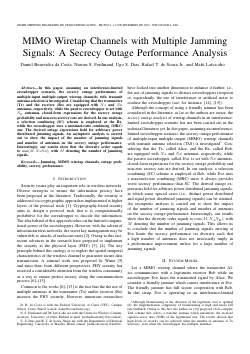
XXXIII Simpósio Brasileiro de Telecomunicações

Aplicação do Algoritmo LBG Ponderado e da Transformada Discreta do Cosseno na Compressão de Imagens
Lia Vogas K. Marrara, Waslon Terllizzie A. Lopes
DOI: 10.14209/sbrt.2015.70
Keywords: Image Processing Vector Quantization Discrete Cosine Transform Mu-Law
Abstract
This paper shows that the quality of coded images based on Vector Quantization and Discrete Cosine Transform could be enhaced by using the weighted LBG Algorithm where the weights are calculated using μ Law. Simulation results show improvements up to 0.62 dB.Download

Engenharia de Tráfego Aplicada a Redes Verde
Débora A. O. Santos, Luiz A. R. da Silva Mello, Marco A. Grivet Mattoso Maia
DOI: 10.14209/sbrt.2015.12
Keywords: Decomposição Benders Engenharia de Tráfego Redes Verdes
Abstract
This paper presents a Traffic Engineering technique applied to Green Networks which concerns on the optimization formulation, rather than on heuristic methods, as usually observed in the literature, and is focused on the backbone of an IP network, presenting an approach to select routers and circuits to be switched off during periods of low n etwork traffic The associated linear optimization program, although frequently very large, can be broken by decomposition techniqu es into several low size ones, thus bringing the original p roblem to the realm of practical feasibilityDownload

Modelamento Markoviano para Transmissão de Símbolos Não Binários Usando Sistemas OFDM em Canais Seletivos em Frequência
Igor Moreira, Cecilio Pimentel
DOI: 10.14209/sbrt.2015.5
Keywords: Finite-state Markovian channels frequency selective fading parameters estimation error probability.
Abstract
This paper evaluates the relevance of using a fi- nite state Markov channel, more specifically the Gilbert-El liot channel (GEC) in order to reproduce the behavior of a discret e communications system, based on the IEEE 802.11 standard, with OFDM modulation and frequency-selective fading. Symb ol errors generated by the transmission of codewords produced by a Reed-Solomon encoder, outer concatenated to the discrete s ystem, are modeled. The accuracy of the GEC, whose parameters are estimated using the Baum-Welch algorithm, is evaluated by comparing some statistics generated by the communicatio n system and by the GEC.Download

Design of Dual - Band and Dual - Polarized Microstrip Antenna for Applications on HAPs
Marcos V. T. Heckler, Cleiton Lucatel, Lucas S. Pereira
DOI: 10.14209/sbrt.2015.14
Keywords: Dual-Band Dual-Polarized Microstrip Antenna
Abstract
This paper presents the design of a dual - band microstrip antenna with dual polarization characteristic for high altitude platforms (HAPs ). The antenna has two isolated ports and is suitable for terminals with receiving and transmitting functions operating simultaneously. The element is designed for operation at 5.8 and 7 GHz with 100 MHz bandwidth in each band. The antenna geometry and its main design parameters are presented and discussed in the paper. Numerical and experimental results show that this radiator exhibits good performance in terms of impedance matching and circular polarization purity.Download

Clustering Strategies applied to Binder Identification using Phantom Measurements
Antoni Fertner, Joao C. W. A. Costa, Reginaldo Santos, Claudomiro Sales Jr., Manoel Lima, Marx Freitas, Caio Rodrigues, Alessandra Araujo
DOI: 10.14209/sbrt.2015.15
Keywords: Binder Identification DSL Phantom-mode mea- surement K-means Gaussian Mixture Model
Abstract
This paper proposes a method for the identification of TPs sharing the same binder, based on the analysis of phantom circuit measurements. Herein, phantoming is used to reveal if a 4-wire loop composed by two TPs are close enough in order to be considered in the same binder. K-means and Gaussian Mixture Model are evaluated on S11 parameter features obtained from the phantom-mode measurement of two TPs. Also, an automatic method to labelling the clusters and a method to estimate the length which two TPs share the same binder are briefly presented. Laboratory results confirm the accuracy of the methods.Download

MIMO Wiretap Channels with Multiple Jamming Signals: A Secrecy Outage Performance Analysis
Daniel Benevides da Costa, Nuwan S. Ferdinand, Ugo S. Dias, R afael T. de Sousa Jr., Matti Latva-aho
DOI: 10.14209/sbrt.2015.175
Keywords: Jamming MIMO wiretap channels outage prob- ability secrecy performance
Abstract
In this paper, assuming an interference-limited eavesdropper scenario, the secrecy outage performance of multiple-input multiple-output wiretap channels with transmit antenna selection is investigated. Considering that the transmitter (Tx) and the receiver (Rx) are equipped with NA and NB antennas, respectively, while the passive eavesdropper is set with NE antennas, closed-form expressions for the secrecy outage probability and non-zero secrecy rate are derived. In our analysis, a selection combining (SC) scheme is employed at the Rx, while the eavesdropper uses a maximal-ratio combining (MRC) one. The derived outage expressions hold for arbitrary power distributed jamming signals. An asymptotic analysis is carried out to show the impact of the number of jamming signals and number of antennas on the secrecy outage performance. Interestingly, our results show that the diversity order equals to min(M,NANB), with M denoting the number of jamming signals.Download

Estudo Estatístico dos Desvanecimentos Associados à Perda de Propagação Móvel no Bioma Cerrado
Paulo H. P. de Carvalho, Plínio R. G. Alves, Giovanni C. G. Alves, João P. Leite
DOI: 10.14209/sbrt.2015.16
Keywords: Cerrado long - term and short - term fading statistics shadowing Matlab
Abstract
This paper presents the evaluation of the fading results on mobile propagation channel at distinct phytophysionomic and geomorphological sorts of cerrado biome. The tested frequencies were 144 and 435 MHz. The programming tasks were developed on Matlab language, release 2008. The methodology applied allowed to set up an appropriate margin level to be added at the estimated propagation path loss value. By doing this, the fading effects may be useful for planning mobile network in cerrado biome. The fading statistics on the forest environment in space - time domain allows, with a reasonable precision, to locali ze morphological structures that accentuate long - term fading. The characterization of the fading and the propagation path loss supports advanced mobile networks planning.Download

Comparison of interpolation methods for missing data reconstruction
Elaine Pereira Lima Scartezzini, Carlos Alberto Ynoguti
DOI: 10.14209/sbrt.2015.17
Keywords: interpolation reconstruction missing data imputation reconstruction Speech recognition under noise
Abstract
The missing data approach was developed to perform automatic speech recognition in noisy environments. This technique identifies and uses in the recognition process only parts of a noisy utterance which were not heavily corrupted by the noise, these parts are called reliable. There are two main methods that can be used to achieve this goal: the marginalization and the imputation. The marginalization method uses only the utterance reliable information, whereas the imputation method tries to substitute the unreliable parts for estimates based on the reliable information. The purpose of this paper is to compare three imputation methods: the linear interpolation, the polynomial interpolation and the rational interpolation.Download

Detecção de Anomalias Em Vídeos Utilizando Dicionários Espaço-Temporais
Mateus T. Nakahata, Eduardo A. B. da Silva, Sergio L. Netto
DOI: 10.14209/sbrt.2015.18
Keywords: Anomalies detection bag of video words spatio- temporal compositions video surveillance
Abstract
This paper presents an implementation of the Spatio- Temporal Compositions (STC) method for the detection of video anomalies. The STC, as the Bag of Video words (BOV), uses a dictionary to eliminate to redundancies, but differs from it by taking into consideration the spatio-temporal composition of small volumes of videos. The STC also performs a modeling using a probabilistic approach, in which anomalous events are those with a low probability of occurrence. Some modifications incorporated to the STC include volume superposition level, spatio- temporal filtering stage and multi-scale computation of probability function. The algorithm used in this model gives good results in the identification of anomalies, without background subtraction, motion estimation or tracking. The system is accurate even with a little training and no prior knowledge of the type of event to be observed, being robust to light variations or cluttered environments, as illustrated by several examples.Download

Warped Discrete S-Transform
Alam Silva Menezes, Moisés Vidal Ribeiro
DOI: 10.14209/sbrt.2015.19
Keywords: Warped S transform Time-frequency representa- tion Warped S Transform
Abstract
This work introduces the warped discrete-time S- transform and the warped discrete S-transform to improve th e time frequency representation of the well-known S-transfo rm. The proposed transforms make use of a non-uniform mapping of tones in the frequency domain to increase the time frequen cy resolution in a specified frequency band. Numerical results show that the warped discrete S-transform can offer better time- frequency representation than discrete S-transform and sh ort time discrete Fourier transform. As a result, it has the pote ntial to increase the performance of techniques based on S-transfor m that have being designed to analyze non-stationary signals. Fin ally, it is demonstrated that the discrete S-transform is a particul ar case of the warped discrete S-transform.Download